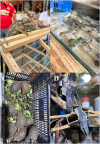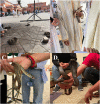Snakes and Souks: Zoonotic pathogens associated to reptiles in the Marrakech markets, Morocco
- PMID: 37467211
- PMCID: PMC10355457
- DOI: 10.1371/journal.pntd.0011431
Snakes and Souks: Zoonotic pathogens associated to reptiles in the Marrakech markets, Morocco
Abstract
The world-famous markets of Marrakech, also known in Arabic as souks, harbor a vast diversity of reptiles that are sold for medicinal/magic/pet purposes or used for snake charming. This unique epidemiological context has never been studied considering the interactions of humans, reptiles, and zoonotic pathogens. Thus, the aim of this study was to identify the parasites and pathogens present in blood and feces associated with handled reptiles in the markets of Marrakech to assess the risk of zoonotic transmission within the reptile-human interface. Privately owned reptiles (n = 118), coming from vendors or snake charmers, were examined and blood and feces sampled. DNA was extracted and molecular screening (cPCR, nPCR, qPCR, dqPCR) was performed aiming to identify potentially zoonotic pathogens (i.e., Anaplasma/Ehrlichia spp., Rickettsia spp., Borrelia burgdorferi sensu lato, Coxiella burnetii, Babesia/Theileria spp., Cryptosporidium spp., Giardia spp., Leishmania spp., Cestoda). Overall, 28.9% (34/118) of reptiles were positive for at least one pathogen. In blood, Anaplasma spp. were detected in four snakes, with two Montpellier snakes positive for Anaplasma phagocytophilum, while Rickettsia spp. were detected in one Mediterranean chameleon and four puff adders. Leishmania tarentolae was molecularly detected in a Mediterranean chameleon and a Montpellier snake. In feces, the cox1 gene generated a myriad of sequences for nematodes, cestodes, fungi and bacteria. Importantly, Proteus vulgaris was identified from a Mediterranean chameleon. Cryptosporidium spp. nPCR yielded a positive sample (i.e., Cryptosporidium sp. apodemus genotype I) from a Moroccan worm lizard, as well as for bacteria such as Pseudomonas aeruginosa in an Egyptian cobra, and Morganella morganii from a puff adder. Results from this study demonstrated the risk of zoonotic transmission of microorganisms and parasites present in blood and feces from reptiles that are brought to the souks in Marrakech, Morocco, to be sold for medicinal purposes or used for snake charming, being in direct and straight contact with humans.
Copyright: © 2023 Mendoza-Roldan et al. This is an open access article distributed under the terms of the Creative Commons Attribution License, which permits unrestricted use, distribution, and reproduction in any medium, provided the original author and source are credited.
Conflict of interest statement
The authors have declared that no competing interests exist.
Figures






Similar articles
-
Parasites and microorganisms associated with the snakes collected for the "festa Dei serpari" in Cocullo, Italy.PLoS Negl Trop Dis. 2024 Feb 21;18(2):e0011973. doi: 10.1371/journal.pntd.0011973. eCollection 2024 Feb. PLoS Negl Trop Dis. 2024. PMID: 38381797 Free PMC article.
-
Molecular identification of tick-borne pathogens (Rickettsia spp., Anaplasma phagocytophilum, Borrelia burgdorferi sensu lato, Coxiella burnetii and piroplasms) in questing and feeding hard ticks from North-Western Spain.Ticks Tick Borne Dis. 2022 Jul;13(4):101961. doi: 10.1016/j.ttbdis.2022.101961. Epub 2022 Apr 23. Ticks Tick Borne Dis. 2022. PMID: 35490548
-
Molecular detection of tick-borne bacteria and protozoa in cervids and wild boars from Portugal.Parasit Vectors. 2016 May 10;9(1):251. doi: 10.1186/s13071-016-1535-0. Parasit Vectors. 2016. PMID: 27160767 Free PMC article.
-
Parasites of reptiles in Iran (1922-2023): A literature review.Int J Parasitol Parasites Wildl. 2024 Sep 16;25:100992. doi: 10.1016/j.ijppaw.2024.100992. eCollection 2024 Dec. Int J Parasitol Parasites Wildl. 2024. PMID: 39323908 Free PMC article. Review.
-
Reptile vector-borne diseases of zoonotic concern.Int J Parasitol Parasites Wildl. 2021 Apr 22;15:132-142. doi: 10.1016/j.ijppaw.2021.04.007. eCollection 2021 Aug. Int J Parasitol Parasites Wildl. 2021. PMID: 34026483 Free PMC article. Review.
Cited by
-
Polyphasic Characterization of Brucella spp. in Livestock Slaughtered from Abattoirs in Eastern Cape, South Africa.Microorganisms. 2024 Jan 22;12(1):223. doi: 10.3390/microorganisms12010223. Microorganisms. 2024. PMID: 38276208 Free PMC article.
-
Navigating Q fever: Current perspectives and challenges in outbreak preparedness.Open Vet J. 2024 Oct;14(10):2509-2524. doi: 10.5455/OVJ.2024.v14.i10.2. Epub 2024 Oct 31. Open Vet J. 2024. PMID: 39545195 Free PMC article. Review.
-
Parasites and microorganisms associated with the snakes collected for the "festa Dei serpari" in Cocullo, Italy.PLoS Negl Trop Dis. 2024 Feb 21;18(2):e0011973. doi: 10.1371/journal.pntd.0011973. eCollection 2024 Feb. PLoS Negl Trop Dis. 2024. PMID: 38381797 Free PMC article.
-
Virulence profile of pathogenic yeasts from snakes: Alternative ways for antifungal strategies.PLoS One. 2025 Mar 12;20(3):e0318703. doi: 10.1371/journal.pone.0318703. eCollection 2025. PLoS One. 2025. PMID: 40072936 Free PMC article.
-
Snakes as sentinel of zoonotic yeasts and bio-indicators of environmental quality.Sci Rep. 2024 Sep 28;14(1):22491. doi: 10.1038/s41598-024-73195-0. Sci Rep. 2024. PMID: 39341972 Free PMC article.
References
-
- Ali T, Marc B, Omar B, Soulaimane K, Larbi S. Exploring destination’s negative e-reputation using aspect-based sentiment analysis approach: case of Marrakech destination on TripAdvisor. Tour Manag Perspect. 2021;40: 100892.
-
- Safaaa L, Housni KE, Bédard F. Authenticity and tourism: what Tripadvisor reviews reveal about authentic travel to Marrakech. Information and communication technologies in tourism. 2017; 595–606. Springer, Cham.
Publication types
MeSH terms
LinkOut - more resources
Full Text Sources
Medical
Miscellaneous

